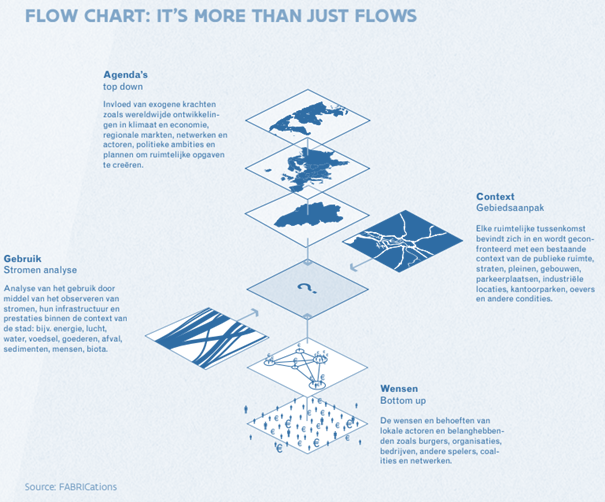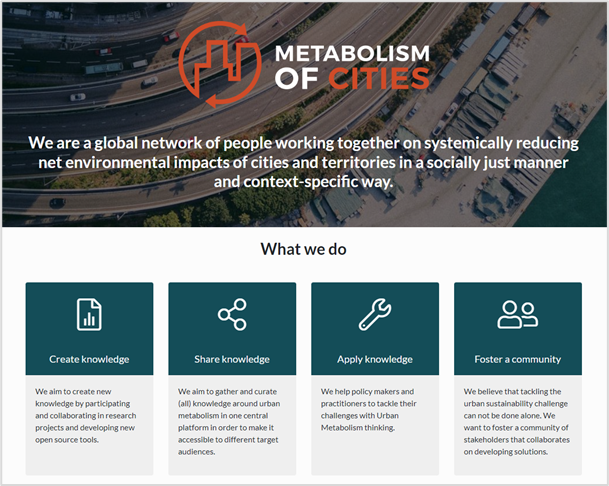This TRACK, with the masterclass series Designing With Flows and the Research by Design in the Flemish/Brussels metropolitan area (city-port and region), has been a stimulating opportunity to take a view of the state of the debate and the choices and strategies involved. Urban metabolism has the potential to act as a boundary object to connect different professional and epistemic communities. Its conceptual richness is a challenge, but also an asset. It provides a springboard for articulating a common agenda, strengthening existing coalitions and bringing to life new constellations of actors.
Metabolism Matters
In practice, the study of an urban metabolism involves “big picture” assimilation and analysis of inputs, outputs, the storage of materials, nutrients, water, energy and any other flows concerning a metropolitan region which can provide sustainability indicators and data.
While the concept of urban metabolism is now gaining momentum in the spheres of academia and government, there are still many aspects that remain grey areas which need to be explored in order to understand the metabolic quantification that is relevant for urban and social economic policies and environmental planning.
More specifically, the spatial perspective of urban metabolism has yet to receive the attention it deserves which poses the question: how can we apply the attributes and advantages of flows to metropolitan life through spatial design? Great efforts are still required to establish urban metabolism as an integral part of urban planning and design, and this requires the design community to become far more enlightened about all the different kinds of flows. The challenge ahead therefore becomes to “design the urban metabolism” of circular, inclusive and resilient port-city regions.
More than just a flows audit
Cities, ports and regions can’t function without constant flows of materials, water, sediment, energy, food, air, biomass, data, and so on. Metabolic studies research these flows and map them, which is how heat maps, potential maps, flow charts, etc. are created.
In the past, these studies were often limited to a kind of audit exercise with input and output data of flows and stocks. Their objective was chiefly to optimise individual flows. While there’s nothing wrong with this, a city is still made up of more than the sum of its individual flows. Models, analyses and indicators are needed and can raise awareness; however, they rarely generate insights into the ‘spatial planning footprint’ of flows, daily dynamics and management, accessibility of flows, and how governments and other players can take action on this front.
Taking context into account
That’s why studies of circular flows should examine the context of the specific areas in which these flows occur. Thanks to the link between research and design practice, current studies take this into account.
In our view, that’s what working with circular economy is all about.
Different agendas (citizens, public authorities, businesses, territory, etc.) are systematically taken into account and local knowledge and valuable initiatives are integrated (see figure). As a result, these studies are always tailored to specific places, at a community level (place-based).
Recommended website
Originally started as a side project, Metabolism of Cities has over the years grown into a network of websites, backed by a non-profit (Brussels, Belgium), and run by different communities consisting primarily of volunteers. By providing an open source, community-led platform, Metabolism of Cities aims to improve the collection, sharing, and analysis of urban metabolism data and tools.
As a non-profit, Metabolism of Cities seeks to support the initiatives that are set up by the community. These initiatives, listed in our Projects section, can vary from a short-term exhibition, to a multi-year effort to catalogue and share data. Some projects involve on-the-ground intervention, whereas others revolve primarily around a digital platform. Some of the signature platforms run by Metabolism of Cities include a Data Hub, Library, Education Hub, and a Multimedia Library. Some key “on the ground”, in-person projects include a set of Master classes, an Urban Metabolism & Minorities project, a Seminar series, and the CityLoops project.



